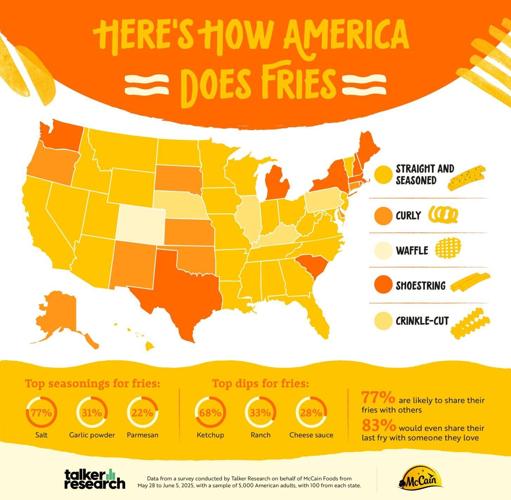
Christopher Williams
Virginia is for fry lovers, according to a new study.
The poll of 5,000 U.S. adults found the average person of the "Old Dominion" self-reported eating at least 21 pounds of spuds, closely followed by three other heavy-hitting states: Alabama, Georgia and Maryland — all with the average person eating about 20 pounds per year.
On average, a single American can eat at least 17 pounds of a small serving (69 grams) of fries per year. Expanded to the entire nation, that means America eats a minimum of 5,610,000,000 poundsof the stuff — as much as 155,833 school buses.
Ahead of National French Fry Day on July 11 and commissioned by McCain Foods, the study conducted by Talker Research revealed variances for one of America’s favorite foods.
While all states can agree that the "best" fries are crispy on the outside and soft on the inside (72%), there are more debates about what type of fry and what seasonings and sauces are best.
Twenty-eight states agreed that straight-and-seasoned fries were top-tier, most popular in North Dakota (55%), Mississippi (54%), Alabama (49%), Wyoming (49%), Louisiana (48%) and Utah (48%).
However, the rest of the nation had varied views on which fry is best.
Classic shoestring fries were most popular in Hawaii (45%), New Hampshire (45%), Michigan (44%), Maine (42%) and Texas (42%).

Curly fries reigned supreme in Alaska (46%), Kansas (46%), Connecticut (45%), and Oklahoma (45%).
Crinkle-cut fries earned top scores in states like Nebraska (51%), Kentucky (46%), and Pennsylvania (43%). Crinkle-cut was also the most popular style of fry in Illinois (41%).
And waffle fries only got love in one state: Colorado (44%).
And no matter what specific type they prefer, two coastal powerhouses were also most likely to experience happiness or joy while eating fries: California (59%) and New York (58%).
Some Americans even have “hometown heroes,” or classic fry dishes that hail from their own backyards. New Yorkers and New Jerseyans are proud to be the home of “disco fries,” while “boardwalk fries” are a Delaware staple.
Those in Illinois enjoy “horseshoe” or “ponyshoe sandwiches” and Californians proudly boast their namesake: the “California burrito.”

Louis Hansel
"Fries are universally loved, but there’s still plenty of debate when it comes to favorites," said Tracy Hostetler, vice president of marketing North America potatoes at McCain Foods. "From crinkle-cut and curly, to waffle and seasoned fries, everyone has their go-to style. We believe enjoying a variety of fries allows everyone to find their favorite."
Despite the friendly disputes on which fry is best, the study found a number of things Americans can agree on when it comes to the world of fries.
Nearly two in three (63%) agreed fries can be considered a main dish, not just a side. According to them, fries shine as mains in dishes like "loaded" fries (66%), chili fries (36%) and topped with various seasonings (36%).
Top seasonings ranged from the classic salt (77%) and garlic powder (31%) to the less orthodox — parmesan (22%), Old Bay (19%), paprika (10%) and cayenne (9%). Top dips were classics as well: ketchup (68%), ranch (33%) and cheese sauce (28%).

(Photo by KoolShooters via Pexels)
Over three-quarters (77%) also agreed they'd share their fries if they were eating with a group of people, being most likely to share with their partner (43%), kids (28%) and friends (21%).
However, 65% admit they’d stolen fries from someone else’s plate.
Eighty-one percent believe fries can even make meals more enjoyable with their family, and 83% said they'd even be willing to share their last fry with someone they love.
"Preferences aside, it's clear that fries hold a special place in people’s hearts across the nation," continued Tracy Hostetler. "They’re the ultimate shareable food — whether enjoying family-style or sneaking one off someone else's plate, fries have a way of bringing family and friends together through that simple, joyful act of sharing."

henry perks
WHAT "FRY" DISH IS YOUR HOMETOWN KNOWN FOR? TOP ANSWERS:
- Boardwalk fries
- California burrito
- Carne asada fries
- Catfish and fries
- Chili cheese fries
- Disco fries
- Fish n chips
- Garbage plate
- Horseshoe/Ponyshoe sandwich
- Poutine

(Photo by cottonbro studio via Pexels)
Survey methodology:
Talker Research surveyed 5,000 American adults, with 100 from each state; the survey was commissioned by McCain Foods and administered and conducted online by Talker Research between May 28 and June 5, 2025.
We are sourcing from a non-probability frame and the two main sources we use are:
- Traditional online access panels — where respondents opt-in to take part in online market research for an incentive
- Programmatic — where respondents are online and are given the option to take part in a survey to receive a virtual incentive usually related to the online activity they are engaging in
Those who did not fit the specified sample were terminated from the survey. As the survey is fielded, dynamic online sampling is used, adjusting targeting to achieve the quotas specified as part of the sampling plan.
Regardless of which sources a respondent came from, they were directed to an Online Survey, where the survey was conducted in English; a link to the questionnaire can be shared upon request. Respondents were awarded points for completing the survey. These points have a small cash-equivalent monetary value.
Cells are only reported on for analysis if they have a minimum of 80 respondents, and statistical significance is calculated at the 95% level. Data is not weighted, but quotas and other parameters are put in place to reach the desired sample.
Interviews are excluded from the final analysis if they failed quality-checking measures. This includes:
- Speeders: Respondents who complete the survey in a time that is quicker than one-third of the median length of interview are disqualified as speeders
- Open ends: All verbatim responses (full open-ended questions as well as other please specify options) are checked for inappropriate or irrelevant text
- Bots: Captcha is enabled on surveys, which allows the research team to identify and disqualify bots
- Duplicates: Survey software has “deduping” based on digital fingerprinting, which ensures nobody is allowed to take the survey more than once
It is worth noting that this survey was only available to individuals with internet access, and the results may not be generalizable to those without internet access.














